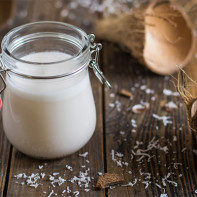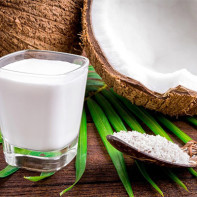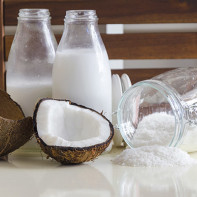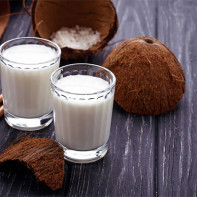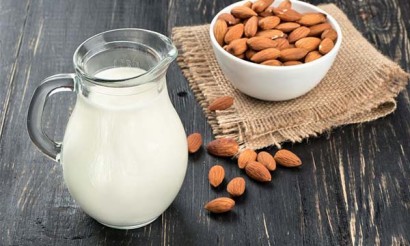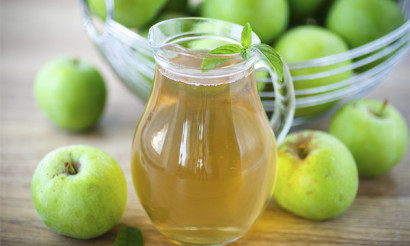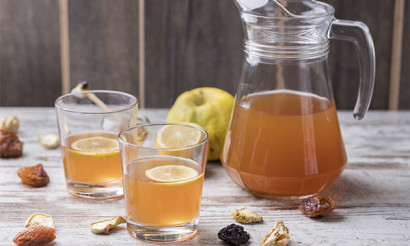How to make coconut milk: 2 ways
Coconut milk is a product that is still perceived in Russia as a rare component of Thai, Filipino, Vietnamese or Indian cuisine, although it has managed to fall in love in Europe as well. It is not a problem to buy coconuts, as well as to cook delicious, healthy and nutritious milk on their own. This article will tell you the best way to do it, why the product is worth adding to the diet and how it can still be used.
- What is coconut milk
- How to choose the right coconut
- How to open a coconut
- How to make coconut milk at home
- Coconut milk from shavings
- Coconut milk from natural pulp and juice
- What can be made with coconut milk
- Oatmeal with Coconut Milk
- Spicy pumpkin soup with coconut milk
- Thai seafood soup
- Indian style chicken in coconut milk
- Dessert omelette with coconut milk
- Strawberry and coconut cocktail with plombard
- What is useful for coconut milk
- Therapeutic Properties of Milk of Coconut Fruits
- The benefits of coconut milk for men, women and children
What is coconut milk
Some people mistake the natural transparent juice inside the fruit - the so-called "coconut water" - for coconut milk. In Asian countries, it is consumed as a refreshing drink and offered to vacationers with a nut with a hole punched and a straw inserted in it. However, real coconut milk from the exotic nut is made by man in industrial or domestic conditions. For this purpose, the juice is combined with pulverized squeezed coconut pulp (or copra, in other words) and water. The result is a white, sweetish liquid with a creamy flavor that can be consumed pure and added to dishes and drinks as an alternative to cow's and goat's milk. It is suitable for Lenten and vegetarian tables and is much less likely to cause allergies than animal milk. Brazilians even compare coconut milk to mother's milk.
In its fresh form, this vegetable milk quickly loses its shelf life; in addition, it is much more caloric than cow's or goat's milk: 229 kcal per 100 ml. It is also distinguished by its density: the richest is called "coconut cream", the top layer of which can be consumed as butter or used for cosmetic purposes.
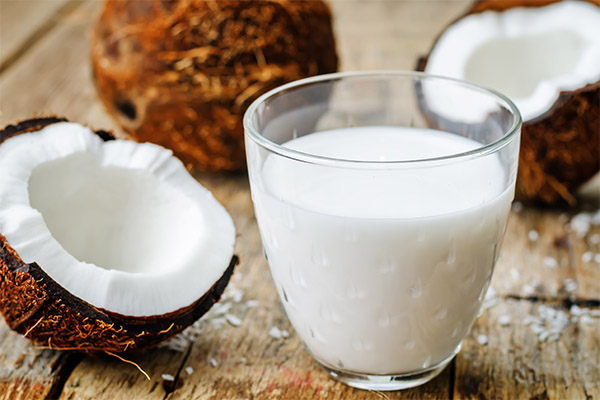
Coconut milk is sold completely ready-to-eat - in cans or bags - or as powder or shavings. Coconut milk is much less useful than freshly prepared coconut milk. And the unhealthy impurities that provide long-term storage - more. It is better to try to make nut milk at home - so you can get a product with a more natural composition, but for this you need to buy the right raw materials.
How to choose the right coconut
This is a coconut fruit, and there is no opportunity to look under the shell in the store or at the market. Sellers are not always aware of the quality of overseas fruits, and may not give reliable information about the conditions of transportation, storage and expiration date. There is no particular season for harvesting coconut fruits - most often they are brought to Russia from Thailand, where, thanks to the climatic features, they mature all year round.
There are a number of external signs by which you can determine the suitability of the coconut:
- The shell is light brown in color. It is dark in overripe fruits.
- Absence of white and pink spots, cracks, and other damage. An indication that the nut is whole, not moldy or pumped with liquid.
- Heaviness and gurgling when shaken in the hand. This is a sign that there is enough juice inside, the pulp is not overdried.
- The three holes - the characteristic holes at the point of attachment to the branch - in a good nut are slightly darker than the rest of the shell and do not sag when pressed.
- A light woody aroma. If there is a pungent sweet smell of coconut pulp coming from the fruit, like pastry chips - it is probably spoiled.
When the nut is purchased, brought home and opened, it is important to pay attention to the color inside and the consistency of the copra. If it is dense, thick, milky-white and easily comes off the shell, you can safely eat the fruit.
The pink hue of the pulp, from subtle to intense, is a signal that it is full of chemicals or has begun to rot. It is better to throw away such a nut or take it to the place where you bought it, so as not to be poisoned.
How to open a coconut
Before proceeding to separate the pulp from the shell, you should first wash the hairy surface of the nut with soap and soap and dry it thoroughly with a towel. It is better to drain the "coconut water" beforehand to avoid its loss. This can be done by piercing one of the three holes on the shell with a hammer and a thick nail and putting a dish under it. Sometimes it is pierced with an awl, pierced with a screwdriver or drilled with a drill. One should try to choose the hole with the softest and thinnest surface. Some pierce all three "eyes", and if the liquid does not flow well - expand the holes.
Important: It is useless to scrape off the brown shell from the edible core with a knife, as beginners sometimes try to do - it is too tough.
There are several ways to break a coconut devoid of water:
- Sawing with a jigsaw, putting the nut on a cutting board. You need to visually divide it in half horizontally or draw a line with a pencil.
- Open with a hammer and a knife. Putting the blade to the line running down the middle of the fruit, hit the knife with the hammer so that the knife slightly enters the top layer. Repeat along the entire line, penetrating all its sections, and then try to break the nut. It will split into two even halves. So it will be easier to scrape off the pulp and it will be possible to save the shell to use it, for example, for crafts.
- To put a nut in a bag and hit it with a hammer - you get many pieces of different size, which will make it difficult to separate the copra. Although this is the easiest and safest way to open the nut.
Then you can proceed to obtain the pulp, this is also done in different ways:
- Tweak with the tip of a sharp knife, separating piece by piece. You can replace the knife with a screwdriver and a hammer. The method is labor-intensive, but it allows you to save useful substances to the maximum.
- Put the nut in the oven, heating it to 150 degrees, for 5 minutes. After that, take it out and let it cool. The pulp shrinks and easily comes off the shell. This is easier than separating the kopra by hand, but heat processing loses vitamins.
Safety precautions should be taken when opening large kernels:
- Don't press the knife too tightly against the surface so it doesn't slip and injure your hand.
- Keep the tools away from your face and eyes: flying fragments of shell can injure them.
- Do not grasp a nut with the whole palm, but only slightly fix it on a board, holding it by the top.
- Work slowly and don't hit the hammer with all your might.
Interestingly, in southern countries, where the product is particularly widespread, the extraction of milk from coconut fruits is approached more simply, without worrying too much about sanitary standards. The unwashed nuts are crushed with a large knife over a basin, threaded on a rod, and the pulp of the copra after being mechanically scraped is placed in a separator and diluted with raw water. The juice of the nut is often not used. It is highly discouraged to consume such a drink unboiled.
How to make coconut milk at home
There are different variants of making the drink on the Web. The simplest ones use ready-made coconut shavings - dried and ground copra. It is a product rich in vitamins and fiber, but high in calories (501 kcal per 100 g) and usually half sugar. Lighter, healthier milk is better made from a semi-finished product that does not include sugar.
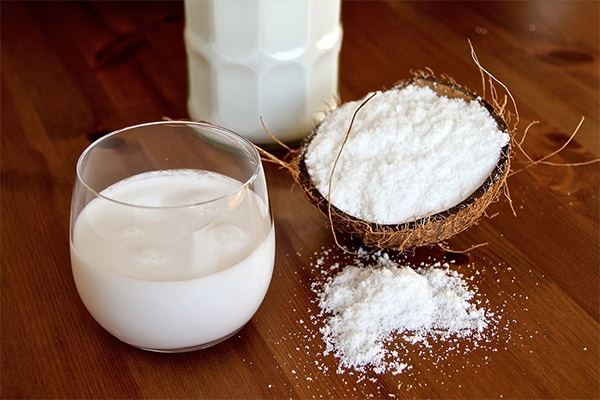
Coconut milk made from shavings
Ingredients:
- coconut shavings - 200 g;
- purified boiled water - 800 ml;
- Sea salt and vanilla powder - 1 pinch each.
How to prepare:
- Grind the chips in a coffee grinder until they are flour, adding salt and vanilla.
- Pour into the bowl of a blender and pour 200 ml of water.
- Allow it to stand for 15 minutes.
- Blend for 5 minutes.
- Pour in the remaining 600 ml of water and blend for 2 more minutes.
- Pour into a clean container and chill.
You can keep it in the fridge for 4 days.
However, the most delicious milk with the highest nutritional value is obtained from the self-prepared parts of the nut, although it is a little more difficult to make.
Coconut milk made from natural pulp and juice
Ingredients for 2-3 servings:
- A medium-sized walnut - 1 pc;
- Boiled chilled water - 500 ml.
Prepare as follows:
- Wash and dry the coconut well.
- Drain the juice and get the pulp from the nut.
- Rinse the copra properly with water, so that there are no brown particles of the shell in it.
- Chop the peeled pulp on a grater.
- Boil water.
- Pour the resulting mass of steep boiling water and leave for an hour and a half.
- Blend the slightly warm mixture with a blender for better separation of liquid.
- Strain the milk through several layers of gauze, wringing out the grounds.
- Combine with the juice poured out of a walnut. This, too, must first be strained.
Pour the milk into a clean container. In a cold place it can stand for 3 days.
It is acceptable to store vegetable milk in the freezer - you need to pour it into molds for ice and wrap it in clingfilm, so that it does not lose its distinctive flavor and is not saturated with foreign odors.
Tip! The resulting cake can be dried and then used for the preparation of confectionery.
What you can make with coconut milk
This type of plant milk is used more often than animal milk. Since, unlike cow's and goat's, it does not curdle during heat treatment and in combination with acidic components of dishes. The cuisine of the peoples of East Asia includes recipes for soups, sweets, pastries, sauces for meat, vegetable and fish dishes, which include a drink from coconut.
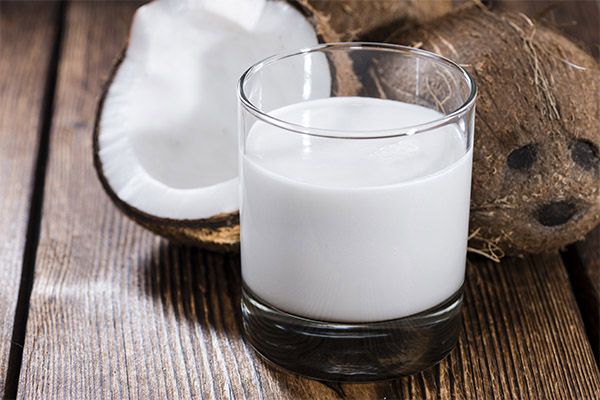
Foods that complement coconut milk well:
- White and red meat, seafood;
- pasta, cereals;
- Animal milk, sour cream, cottage cheese, cream;
- Fresh and dried fruits and berries;
- vegetables, especially peppers, carrots, tomatoes, and pumpkins.
Most often, plant milk is used as a substitute for cow's or goat's milk for those who are lactose intolerant (the carbohydrate found in dairy products - popularly known as "milk sugar").
Important: In diet recipes, where animal ingredients are replaced by vegetable ones, due to the high energy value of coconut milk it is usually taken half as much as cow's or goat's milk.
Oatmeal with coconut milk
Ingredients:
- Non-coarse ground oat flakes - 1 tbsp;
- coconut milk - 400 ml;
- drinking water - 100 ml;
- honey - 1 tbsp;
- Chopped walnut kernels - 1 tbsp.
Method of preparation:
- Pour the coconut milk into a deep saucepan and put on a low heat, wait until it boils.
- Add water and bring back to the boil.
- Pour the oats into the pot.
- Cook for 5 minutes, stirring occasionally.
- Remove the pot from the heat and leave to cool slightly.
Before serving, put honey and sprinkle the porridge with nuts. Oat flakes can be replaced with rice flakes. Boil the porridge from semolina in a similar way.
Spicy Pumpkin Soup with Coconut Milk
Ingredients:
- Pumpkin pulp - 1200 g;
- coconut milk - 1 cup;
- water - 1,5 l;
- onion - 2 pcs;
- olive oil - 1 tbsp;
- soy sauce - 2 tbsp;
- medium ginger root - 1 pc;
- nutmeg powder - 2 gr;
- fresh garlic - 2 cloves;
- Hot ground pepper and other spices - to taste;
- any greens.
Method of preparation:
- Coarsely chop the garlic and onion.
- Diced pumpkin put in a deep pan and pour cold water, cook over medium heat.
- Fry onion and garlic in olive oil until golden.
- Add finely grated ginger root and cook for 1 minute.
- Put the sautéed vegetables into the pan with the pumpkin and cook until the pumpkin is tender.
- Remove the soup from the heat and cool slightly.
- Blend to a liquid purée, add the coconut milk, sauce and spices, then whisk again.
Before serving, sprinkle soup with finely chopped greens.
Thai style seafood soup
Ingredients:
- tomatoes - 2 pcs;
- peeled shrimp - 300 g;
- squid rings - 200 g;
- Tom Yum paste - 1 packet;
- coconut milk - 100 ml;
- any vegetable oil - 5 tbsp;
- granulated sugar - 1 tbsp;
- ginger root - 100 gr;
- chicken broth - 2,5 cup;
- herbs - 1 bunch;
- Lime - 1 pc.
Method of preparation:
- Peel the ginger root and finely chop.
- Roast the ginger and then stew a little in the oil with the paste.
- Put the seafood in the chicken broth, bringing it to the boil.
- Add the ginger and tomato slices to the broth.
- Pour in the coconut milk and sprinkle with the chopped herbs.
- Add squeezed lime juice and sugar at the end of cooking.
The soup should not be boiled over high heat, as it will not boil over, and it should be seasoned with salt - the pasta is already salty.
Chicken in Indian coconut milk
Ingredients:
- Boneless chicken fillet - 1 kg;
- coconut milk - 1 cup;
- Curry seasoning - 1 tsp;
- turnip onion - 2 pcs;
- garlic - 2 medium sized slices;
- ginger (fresh or powdered) - 0.5 tsp;
- flour - 1 tbsp;
- water - half a cup;
- vegetable oil and salt to taste.
Method of preparation:
- Cut the fillet into small pieces.
- Diced onion fry with minced garlic and ginger, if you want you can add chopped green pepper.
- Add turmeric or use curry instead for a bright yellow color. Sauté some more.
- Add the chicken fillet to the vegetables. Fry the pieces, stirring lightly.
- With a little salt, pour a glass of water, put the lid on the pan and stew for 15 minutes.
- Open the lid and stir-fry over high heat until all the liquid has evaporated.
- Mix coconut milk and flour in a separate saucepan until smooth.
- Gradually add milk to chicken and vegetables, stirring until sauce becomes thick.
- Remove from heat and place in a bowl. Rice is good as a side dish.
Dessert omelet with coconut milk
Ingredients:
- egg - 3 pcs;
- Coconut milk - 40 ml;
- banana - 1 pc;
- vegetable oil for frying - 10 ml;
- flax seeds and coconut flakes for decoration.
Method of preparation:
- Beat eggs with a whisk and pour in coconut milk.
- Slice banana into pieces.
- Heat a frying pan with a little oil.
- Pour egg-milk mixture and place banana pieces on top, fry under the lid on low heat for a few minutes.
- Sprinkle coconut shavings and flax seeds on top.
Strawberry and Coconut Cocktail with Plombière
Ingredients:
- coconut milk - 200 ml;
- powdered sugar - 50 gr;
- strawberries (it is possible to take frozen) - 1 cup;
- Strawberries (you can take frozen) - 1 cup; Ice cream - 200 gr.
Method of preparation:
- Mash the strawberries to a smooth pulp with a fork or blender.
- Combine all the ingredients in a bowl and beat with a blender until bubbles appear.
- Add the powdered sugar.
- Pour the cocktail into glasses, garnished with berries, powder, coconut or chocolate shavings, mint leaves.
What is coconut milk good for?
In some countries, the nutty drink is endowed with the property to work miracles, to revitalize and rejuvenate the body, to give a person strength and energy. There are reasons for this.

Coconut milk, because of its density, calorie content and naturally sweet taste, is sometimes perceived as an unhealthy product with too much fat. Coconut milk is indeed rich in them, but they are among the useful and easily digestible fatty acids, which give a quick feeling of fullness and strength, normalize blood pressure and cholesterol levels.
Approximate chemical composition of one cup of unprocessed nut milk:
- proteins - 5 g;
- fats - 57.2 g;
- Carbohydrates - 13.3 g;
- energetic value - 552 kcal;
- dietary fiber - 5.2 g.
Plus a whole list of vitamins and trace elements that are essential for health - copper, iron, manganese, phosphorus, magnesium, selenium, potassium, zinc, vitamins C, B, E and B6, as well as nicotinic acid, useful for heart, blood vessels and nervous system, and thiamine, which accelerates brain function and improves memory.
Therapeutic properties of milk from coconut fruits
- Reducing blood pressure and cholesterol levels, stabilizing heart function. Lauric acid, which is half the fat of coconut milk, with regular use lowers low-density lipoproteins, "responsible" for the formation of cholesterol. Magnesium, a mineral that relieves muscle tension, is good for the cardiovascular system.
- Help in the fight against excess weight. The energy derived from the fatty acids contained in milk is consumed by the body until the end, and the feeling of satiety they give is maintained for a long time.
- Strengthening of teeth and bones due to the sufficient content of calcium and phosphorus elements.
- Benefits for the digestive system. Due to the absence of animal proteins, which some people cannot tolerate, the gastrointestinal tract is not irritated and constipation does not occur. Electrolytes and beneficial lipids well hydrate the mucosa of the internal organs and promote healing of gastric ulcers.
- Reduced sugars. Due to the high percentage of fat, the rate of glucose release into the blood slows down.
- Blood enrichment with iron, which is especially important to prevent the development of iron deficiency in people who refuse to eat meat.
- The antiviral activity of lauric acid. It is due to the fact that in the body acid is converted into the substance monolaurin, able to destroy the lipid shell of measles, influenza, herpes and human immunodeficiency viruses.
- Strengthening the body's defenses due to the presence of vitamin C.
- Combat joint diseases. The selenium contained in coconut milk prevents the action of free radicals that cause aging and destruction of the joint sac.
- Slowing the development of Alzheimer's disease. The nutrients in coconut milk are converted by the human liver into ketones, from which the brain takes extra energy to function.
The benefits of coconut milk for men, women and children
For the female body, the benefits of the product can hardly be overestimated. Micronutrients, vitamins and antioxidants contained in coconut milk help you stay young and full of energy for a long time. Thanks to its antimicrobial property, it slows down the growth of opportunistic flora, which can lead to malfunctions in a woman's intimate health. Coconut milk allows expectant mothers to maintain the necessary level of iron in the blood and gets rid of sharp fluctuations of hormonal background, causing irritability, anxiety and tearfulness. It makes the passage of menopause more gentle for the nervous system.
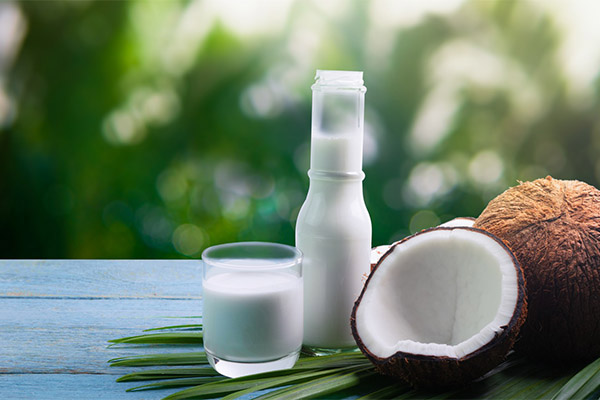
Coconut milk is widely used externally - in professional and folk cosmetology. With its help restores the density of hair, nails strength, moisturizes the skin. It is an effective tool for getting rid of wrinkles and stretch marks.
For men's health milk coconut is also beneficial - especially for the reproductive sphere. Its regular use helps to raise testosterone and prevents the development of benign prostate cancer. Selenium and zinc favor spermatogenesis. Milk nut gets rid of obesity and stress, improves performance, helps build muscle mass.
Coconut milk for children is an unusual and vitamin-rich treat. However, we must take into account that the fruit from which it is made is exotic and unusual for northern latitudes, so it is unclear how it will react to the baby's body. According to nutritionists, a child should not be introduced to peanut milk before the age of two, or better yet, three years. For the first time it is better to give him no more than 1 tsp. drink in half with water. You must carefully monitor allergic reactions, if it appears - you can try to give him another time in about a year. If all goes well, do not indulge your child coconut milk more than twice a week.
Coconut milk is less and less often perceived by consumers as an exotic oddity and is increasingly on the menu of fans of healthy lifestyles and vegetarian diets. Thanks to the available information on the Internet, people are learning about its therapeutic properties and powerful health-improving effect. But if there are health problems, it is not unreasonable to get advice from a specialist before trying a new product for yourself.
«Important: All information on this site is provided solely for introductory purposes only. Before applying any recommendations, consult a health care professional. specialist. Neither the editors nor the authors shall be liable for any possible harm caused by materials."


